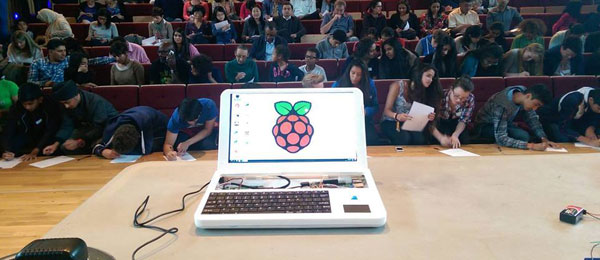Pi-Top, a Raspberry Pi Model B+ powered build-your-own-laptop kit, soon could enable users to learn computer programming, designing and 3D-printing skills.
The Pi-Top team recently released details on its construction of a prototype computer in a Reddit post.
The developers plan to use the model in a Kickstarter campaign to generate funding for the project. They printed the prototype in four parts with a Rostock Max V2 printer.
That process took about 160 hours to complete, but a new design has shortened the total print time dramatically — to roughly 60 hours. That design change also made the files much easier to print than the original prototype, according to Jesse Lozano, cofounder and software developer for Pi-Top Facebook and Twitter (@GetPiTop).
If the project proceeds as planned, customers will buy a prebuilt kit or opt for the 3D printer files and print their own components. Either method will gain them access to a series of hands-on learning guides about designing and programming printed circuit boards.
The lessons would be available for free from the Pi-Top website — but that is contingent on Kickstarter pledges actually providing the funds needed to support the development and marketing processes.
“Printing the laptop was a huge challenge, especially as we had no experience in 3D printing before this,” Lozano told TechNewsWorld.
Product Proposal
The Pi-Top laptop is a Raspberry Pi Model B+ powered machine that you build yourself from a kit. The price is not yet available, but the developers say they will make it accessible so that most anyone can build a fully functional laptop.
The prototype and planned production model is a full-sized 3D printed laptop that houses a Raspberry Pi micro computer in the case. The kit is a tool that takes users through each component’s functionality to learn how to use the Pi-Top to build their own projects.
Besides the hardware kit, the plan is to provide free lesson packages to teach users hardware and software skills, starting with the basics and stepping through to advanced processes. The goal is to enable users to start 3D printing, design their own printed circuit boards, and create complete products.
Pi-Top Specs
The Pi-Top is designed with a fully integrated keyboard and track-pad with extra ports. A clear sliding panel provides access to the components.
The Kickstarter DAY 1 edition Pi-Tops will feature a laser-etched panel design in addition to the standard clear panel. The build-it-yourself kit will include the latest Raspbian OS.
The Pi-Top laptop will deliver a battery life between six and eight hours. It will be WiFi-enabled out of the box for full mobile use. It includes a 13.3-inch high definition LCD screen (1366 x 768).
Challenging Tasks
The first challenge the Pi-Top team had to meet was incorporating a high-quality screen that was also low cost.
The development team designed a custom HDMI-to-LVDS bridge circuit for Pi-Top, according to Lozano. The circuit takes the HDMI signal from the Raspberry Pi and converts it to LVDS format, which is what affordable LCD screens require.
The biggest challenge was getting the support structure just right, Lozano said. That allowed them to print horizontal and other shallow angle surfaces.
Since the parts were so tall, the team had to use floating blocks to tie the support structure to the vertical parts of the object, like scaffolding. That technique prevented it from swaying when the print nozzle moved side to side at high speed.
Due to the lengthy printing periods, there was a greater chance of problems developing. To counteract those risks, the team worked through the night to monitor the printing so that any jams, blockages, filament entanglements or such could be dealt with before they caused problems.
Hitting the Benefit and Goal
With Pi-Top, you will understand all the technology that goes into building mobile devices, Lozano promised. The ultimate goal is to make hardware as accessible as software is now.
The kit focuses on teaching transferable skills. For example, the team recently taught students how to create a basic LED circuit and code it to turn on using the Pi-Top. Students then used that knowledge to code a basic robot, said Lozano — all in less than three hours.
“A huge problem with hardware is the lack of real practical learning resources from beginner stages and affordable options to learn from,” he said.
No Lab Animals Needed
The Pi-Top approach could go a long way in furthering an interest in learning technical computer skills. Real tech-savvy is building and programming devices, noted Carla Schroder, ace Linux guru at Carla Schroder’s Linux Country.
“Knowing how to click buttons is not tech-savvy. Lab animals quickly learn to push buttons and pull levers,” she told TechNewsWorld.
Pi-Top looks like a great project for learning the fundamentals of designing, building and programming a simple computer. Raspberry Pi has already proven its worth as both an educational tool and a useful platform for building useful devices, she pointed out.
“The real tech revolution begins when we attain a critical mass of makers and hobbyists hacking on projects like this and building devices that other people can hack and build on,” Schroder said.
Hands-On Appeal
One of the most valuable things about the Pi-Top process is that its assembly leads users to appreciate computing more viscerally and intimately than a simple trip to Best Buy or Amazon does, noted Charles King, principal analyst for Pund-IT.
“Just because personal computing has become commoditized doesn’t mean that users need to limit themselves to being mere consumers,” he told TechNewsWorld.
“In much the same way that auto shop classes once educated generations of more knowledgeable drivers,” King said, “the Pi-Top team seems engaged in ensuring that at least some next-gen IT users will be intimately acquainted with the machines that are impacting and changing their lives.”




















































